"Crumple Like A Telescope..." MTB Injuries (Part 2)
Posted by Jeremy Windsor on Oct 28, 2021
Thanks to members of the mountain medicine community my knowledge of mountain biking injuries has grown exponentially in recent weeks! In the last post we took a look at soft tissue injuries and finished with Nick Fisher’s extraordinary description of a bear attack. In this post we’ll focus upon the bony injuries sustained by MTBer’s. With us for the ride are orthopaedic surgeons Tim Halsey and Mike Rodgers who’ll share their knowledge and experience along the way. But first, here’s Robin Barraclough, MTBer and Christchurch-based doctor, to set the scene…
"The mechanism of falling off makes injuries quite reproducible. A fall onto an outstretched hand means wrist, elbow and clavicle injuries form a sizeable cohort as people protect themselves when they come off. Loss of control at greater speed means head and spinal injuries kick in - often the hyperextension or hyperflexion of the vertebrae - reflecting how much someone has rotated before impacting with the ground”
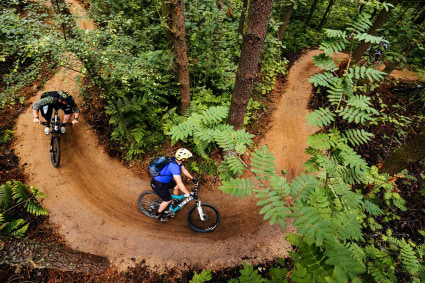
According to Mike Whiteside, “I’ve managed to fall off every few months for the last 20 or so years I’ve been mountain biking. Some are conditions related, some bike setup but most are a lack of skills and concentration…”
To get a feel for where MTBers get their fractures it’s worth taking a look at the evidence we have available. In the largest UK study of MTBers to date, researchers in Scotland identified a total of 80 fractures in MTBers who'd visited the Glentress MTBing Centre*. 51 were identified in the upper limbs with the majority affecting the clavicle (21) and bones in the wrist (10). Let's start by taking a look at two very different clavicle fractures. First, Abbi Forsyth, anaesthetist and DiMM holder, describing her recent fall,
"My injury wasn’t a typical mountain bike injury in that I was on the road less than a kilometre from home having done 40km in the White Peak on my mountain bike at the end of July 2021 but the mechanism is likely similar.
I was on a narrow single-track road and came round a corner to come face to face with a large pickup truck. I braked but unfortunately hit a patch of gravel at whilst my bike went to the side, I went straight onto the car bonnet with a direct impact to my shoulder.
Having broken my other clavicle when I was 12 in a horse-riding accident, I knew immediately what I had done, the pain was extraordinary, my shoulder looked deformed and there was a big step in my clavicle when I felt along it.
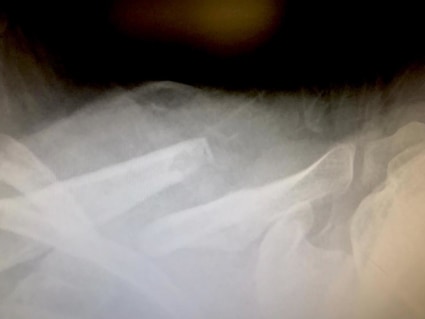
An X-ray of Abbi Forsyth's fractured clavicle - according to Mike, "a midshaft left clavicle fracture which appears to be shortened by approximately 2cm and displaced by 2cm"
Once I’d scraped myself off of the road, a displaced left clavicle fracture was confirmed on an x-ray in ED. In hindsight, I was incredibly lucky to just have the injuries that I did given the significant mechanism.
I was lucky enough to be treated in the same hospital where I work as an anaesthetist and was offered a clavicle ORIF 2 days later. The pain in these 2 intervening days cannot be overstated and was difficult to control and I was grateful to be treated so quickly.
My fracture was 100% displaced with significant shortening of 2cm and it was thought there would be a high chance of non-union if treated conservatively.
Recovery? Ask me this in a few weeks! Realistically I am looking at at least 6 weeks off work before a phased return to work, use of my left arm and shoulder being somewhat crucial for an anaesthetist!"
Next up is Richard Dobson, Consultant in Anaesthesia and Intensive Care at Chesterfield Royal Hospital, who describes his fracture and a much longer recovery...
"I was on my way home from St Helena for Christmas. I’d caught the Mail Ship to Ascension Island and was waiting for an RAF flight to the UK. I was cycling alone, I was tired as I’d been to the US air base ‘Volcano Club’ the night before and I was up at 5am watching turtles laying their eggs. I’d been on a 30km ride around the island and about 2km from home, not concentrating, doing maybe 30kph I think I hit a bump and came off. I wasn’t wearing a helmet, as with a population of 400 the traffic is pretty light and the island being made of black volcanic rock it is hotter than the sun. I hit my head and can’t remember which bit of me hit the ground first, the next thing I remember is sliding down the road on my back in pain. I picked myself up and cycled home on adrenaline, my arm was sore and couldn’t put any weight through it. A buckled wheel and a puncture made for an unpleasant ride home but there was no chance of me fixing it.
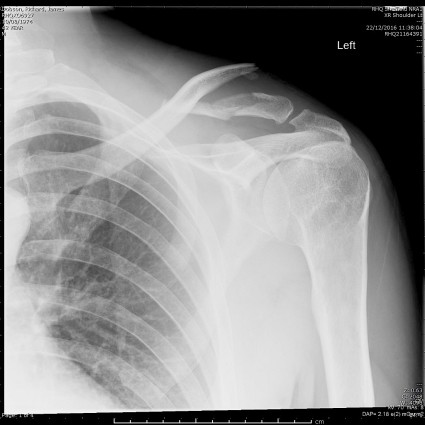
An X-ray of Richard Dobson's fractured left clavicle - according to Mike, "a comminuted (more than 2 pieces) lateral third left clavicle fracture with approximately 2.5cm of displacement"
I went to the hospital, there was only one nurse on duty, and fortunately it was a very attractive Brazilian nurse who cleaned up my wounds. The discomfort of large areas of road rash on my back and elbows down to the bone being washed with betadine was only partially distracted by her beauty. We read the instructions on how to take a shoulder x-ray and we took an x-ray. The nurse felt obliged to called the doctor who couldn’t stay long as he was also the projectionist and it was film night so had to rush. I took codeine and drank ‘Commando’ rum for 2 days until I caught the flight home.
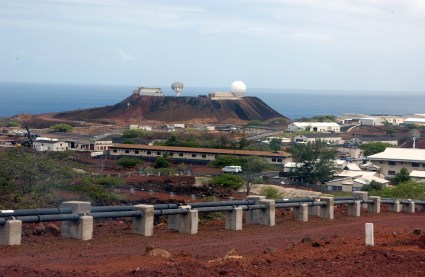
Ascension Island is an isolated volcanic island that lies just 7 degrees south of the equator. It lies approximately 1000 miles fom Africa and 1400 miles from South America, making a medical evacuation very challenging!
Back in Sheffield I was operated on that evening and discharged home the next morning. I think the fracture was comminuted and it needed fibrewire to bring it together before plating. I think the CC ligament was involved so I had the shoulder fully immobilized for 6 weeks, then passive movements only for 6 weeks. It was then a very stiff and weak shoulder, I had previously broken that proximal humerus so it was already a weak rotator cuff. I needed hydrotherapy to get moving and then ongoing physio for a year.
I was still getting discomfort on moving so I had a CT scan as there was a question of non union. The CT suggested the fracture was stable so the plate was removed at 18 months. Pain improved with the plate removed but on any movement I get a pulling sensation which is either the CC ligament or AC joint, I’ve been offered shaving the end off the clavicle which does stick up, but happy to live with it.

An X-ray of Richard Dobson's left clavicle after surgery
I needed 6 weeks off work and then 6 weeks non clinical. On return to work I struggled at times particularly with a difficult airway. Not having dependants I don’t have income protection and quickly realised you need 2 arms to be a decent anaesthetist.
Psychologically I found it hard not being at work, then difficult at work being non clinical, I felt a spare part and frustrated. The pain while not excruciating went on for 18 months. Laying in bed it would be the last thing I thought about at night and first thing I thought of waking up. It probably got me down more than I realised. I still get discomfort on moving but have come to live with it and I have accepted it will be with me for the rest of my life. I keep reminding myself it could have been worse, I’d had a head injury on a remote island with the nearest neurosurgeon 48 hours away".
Here's Mike Rodger's thoughts on the management of clavicle fractures,
“Most clavicle fractures heal without intervention and leave a simple bump or step.
My indications for operating include - open fractures or those with soft tissue compromise (“tented” skin or ischaemic changes over fracture site), those with a neurovascular injury and significant lower limb injuries requiring mobilisation with walking aids. A clavicle fixation can get people out of bed early! Those with a concomitant scapula fracture (“floating shoulder”) also tend to need surgical repair.
Most high energy, comminuted or widely displaced fractures will heal, but this group does have a slightly higher risk of delay to union or non-union. Fixing clavicle fractures may reduce the risk of non-union in this group. Surgery often leaves a numb patch on the anterior chest wall, including the nipple, leaves a scar and metalwork that can irritate when load carrying on shoulder. Surgery also has the general risks of 'being in hospital' - infection, lung puncture, neuroma, scar issues, generic risks of surgery, DVT, etc. Bumps can be shaved when the fracture is healed. As I recall, about 25 % of plates are removed because of local irritation. When the fracture has healed and the swelling is no longer hiding the plate, the metalwork is immediately subcutaneous to a scar. Those who carry rucksacks, bags and scaffold poles really don't like having the plate there!
If I broke my clavicle, I’d need a good reason to get it fixed!”
As the Glentress study shows, following up close behind clavicle fractures are bony injuries to the wrist. Here’s Simon Currin, GP and leader of MEDEX, with his experience of a recent fracture,
“On a winter trip to the Forest of Dean Mountain Bike Centre a very pleasant guy on a full suspension, carbon state-of-the-art mega machine described our bikes as, 'classic retro wheels'. How right he was as salt had corroded the callipers on our disk brakes meaning that they were permanently welded on making pedalling even harder work than it would normally be. Full bike services were commissioned to update our retro wheels and new Shimano XT brakes with over-sized disks were fitted. That's where it all started to go wrong!
An after work cycle up our local hill brought us to the limit of our lockdown area on a glorious spring evening. There followed a fast descent over terrain that we have both cycled hundreds of times. I tucked in close behind Sally and was enjoying the ride when she stopped suddenly to watch a startled hare. I was too close and braked hard to avoid crashing into her at 20mph. The new Shimano XT's were infinitely more powerful than their predecessors and my bike bucked and somersaulted and my right wrist absorbed all the kinetic energy as I punched the ground at 20mph. I felt it crumple and collapse like a telescope.
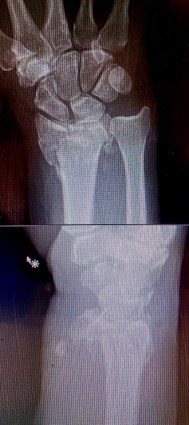
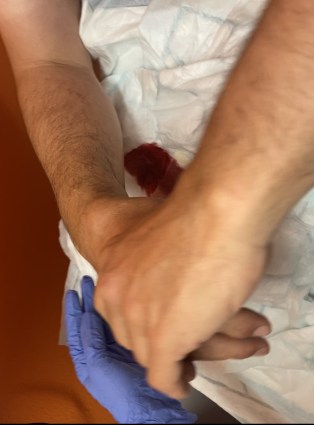
Simon's swollen right wrist and x ray - described by Tim as, "multi-fragmentary far distal radius fracture involving the radio carpal joint and sigmoid notch with compensatory carpal malalignment"
The crack happened half a mile from home and Sally was soon back with the car and fashioned a splint out of Karrimat to support my wrist for the trip to A&E. There I got IV antibiotics as I'd gashed the skin adjacent to the fracture before being transferred in a back slab to a regional orthopaedic centre for a 2 hour internal fixation and 3 months off work.
A year later and my wrist is probably about as good as it's going to be. I'm back on my bike but have transferred the twist grip gear change on my road bike to the left side as I couldn't change gear comfortably with my right hand. I now descend hills much more cautiously and make sure I'm always helmeted!”
I asked Mike what constituted a "bad" wrist fracture. Here's what he said,
"Intra-articular fracture with significant angulation and shortening. Surgery is there to correct this. Open fractures need to be washed out and stabilised.
In the long term, pronation and supination are likely to be reduced. This is likely to be permanent and frustrating. Wrist flexion is likely to be reduced, but doesn't bother people as much as loss of rotation. Later, post traumatic arthritis can occur if the intra-articular fracture is not reduced".
Here's Tim on what needs surgery,
"Depends on patient age, activity level and functional demand. Fracture geometry and extent of displacement.
The usual angles are 22 degrees radial tilt on PA film (permitted to fall down to 15 degrees before intervention) 11 degrees volar tilt on lateral view (allowed to go to just beyond neutral) and the extent of the articular step with 2mm being the oft quoted figure although this is debated. Articular gaps are probably tolerated more than steps. With any articular fracture the permitted step is the thickness of the articular cartilage (so less in the proximal interphalangeal joint and more in the knee) so as to avoid exposing the subchondral bone and thereby producing mechanically driven cartilage damage".
Whilst the vast majority of fractures occur in the upper limbs there are a number affecting other sites too. Amongst the 29 remaining fractures in the Glentress study, 24 affected the axial skeleton (skull, spine, ribs and pelvis) and 5 in the lower limbs.
Here’s Mike Whiteside, Consultant Physician and DiMM holder, describing a ride through Sheffield’s Rivelin Valley in March 2020,
“Two mates had never done this ‘cheeky descent before’. Giles used to ride downhill in the era of Steve Peat’s heyday and was just getting back into things. I was fitter but less skilled (still remains true to this day). This was an opportunity to show my mettle. Well it was until he caught me up and I ended up folding the front wheel and going over the handlebars. On sitting up my neck and back really hurt but I carried on for another hour or so. At that point the pain was too much and I headed for home.
I was bruised over my left lower ribs but went to sleep on it. Next day, boy it hurt! I felt a popping sensation on pushing - that’s a broken rib – I thought. Perfect timing just before lockdown!”
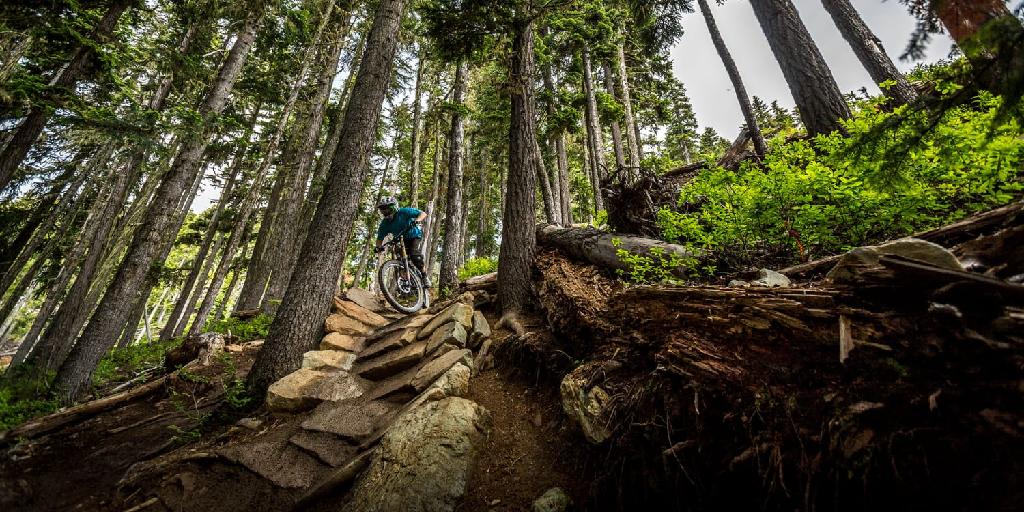
Meg Owen puts it brilliantly when she writes, "This one is less of a mechanism and more an environment. To guarantee injury gather a group of blokes for a MTB day, ensure one is less experienced than the rest but a bit gung ho and will try and keep up anyway. Results? 2 knock outs, a few grazes and a broken collar bone..."
Here’s Roger Kockelbergh with a description of a bony injury to the lower limb,
“A group of us set out to ride the King Alfred's Way over 3 days using either gravel or mountain bikes. All were carrying bike packing luggage. On the first morning there were two significant crashes related to ruts. The first was in a deep vehicle made rut on flat ground. Too late, Rider 1 realised that another rider was in the same rut travelling in the opposite direction. He made an attempt to change ruts but caught his front wheel on the wall of the rut, landing on his knee on sharp flint.
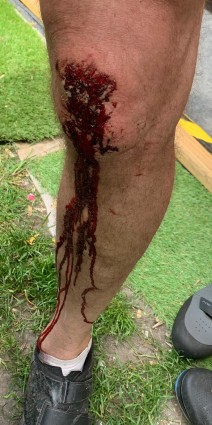
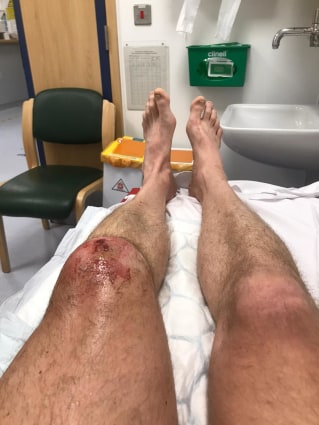
A fractured patella after 100km of cycling...
He had a laceration at the level of the patella, which continued to bleed for a further 100km. He complained that the knee was stiff if he stopped, but loosened a few minutes after each restart. He then spent an uncomfortable night despite simple analgesia and ice. He abandoned and attended a local A&E. A compound fracture of the patella was diagnosed and it was treated conservatively. He is making a good recovery.”
I asked Mike if it was common to continue exercising with a fractured patella. Here’s what he said,
“No, not that common! The patella is a sesamoid - a bone within a tendon. If the surrounding tendon is in continuity, the knee extensor apparatus still works. But it's a rare patella fracture that is just broken enough to be called a fracture but isn't so broken that the tendon is not disrupted nor the backside of the patella is no longer a contiguous surface to enable glide over the front of the femur.
Vertical fractures are mobilised cautiously. Transverse fractures are fixed, to counteract tensile forces. A smashed patella used to be excised, but this is rare now as there is a significant loss of mechanical advantage if the patella is taken. The goal of surgery is to restore a smooth posterior gliding surface and integrity of the extensor apparatus. Therefore most patella fractures need to be fixed.
Unfortunately, protecting the fracture reconstruction by limiting the knee’s range of motion leads to stiffness and quads weakness. These issues are the frustrating tail end of the injury".
No account of MTBing fractures would be complete without mention of spinal injuries. Amongst those identified in the Glentress Study, fractures occurred in the thoracic (1) and lumbar spine (1). In a larger study conducted at British Columbia's Whistler Bike Park, 21 out of 445 fractures affected the spine**. This included a case of quadriplegia sustained in a MTBer who fractured C7. First up, Roger Kockelbergh describing a "near miss",
“The second crash happened 10 minutes later. Rider 2 was following rider 3 in a deep tractor rut, they were riding downhill quickly but in control, however the rut included two deeper holes which rider 3 negotiated. Rider 2 hit the first hole and remained in control but his weight was forward, and on hitting the second hole he was thrown over the handlebars landing directly on his head. He sustained a sore and stiff neck, helmet shaped abrasions to his scalp and a badly broken helmet. He diverted to the nearest bike shop for a new helmet but did not seek medical attention. The abrasions healed quickly and the neck symptoms settled within 4 weeks with no adverse effects.”
Unfortunately, some are rather less fortunate. Here’s Intensivist Andy Luks describing a MTBer he treated,
"Several years ago I took care of a 27 year-old man who suffered a high cervical spinal cord injury whilst riding his mountain bike. He went off a 5 foot jump and when he landed, pitched over the handle bars and landed — helmeted at the time — directly on the top of his head. He immediately lost all motor function and was insensate below his shoulders. He was transferred to a hospital where he was found to be hypotensive and in need of vasopressors. Fortunately, he was breathing spontaneously. A CT scan revealed a burst fracture of the C4 vertebrae with extension into the spinal canal and he was subsequently transferred to our hospital. He had no other injuries.

Hypotension commonly occurs in those with spinal injuries affecting T6 or above. This is due to damage of sympathetic fibres essential for vasoconstriction. It is most often seen following the induction of anaesthesia and institution of mechanical ventilation. Over the course of 4-6 weeks this resolves as the activity of sympathetic reflexes increases. Distension of the bladder is a potent stimulus of this - often triggering sweating, vasoconstriction and hypertension
Upon arrival he was found to be breathless and noted to have an increased partial pressure of carbon dioxide on an arterial blood gas. He was intubated, placed on mechanical ventilation and transferred to the operating theatre for surgical stabilization of his spine. He had a relatively uneventful stay in our ICU and following the placement of a tracheotomy tube was transferred to the acute inpatient rehab ward. He was eventually able to wean himself off mechanical ventilation prior to discharge. Over the course of several years he regained a degree of function to the point that he is now described as having a C5 AIS B injury. Six months following his injury, he was riding a sit-ski device at a ski resort and is now back at work."
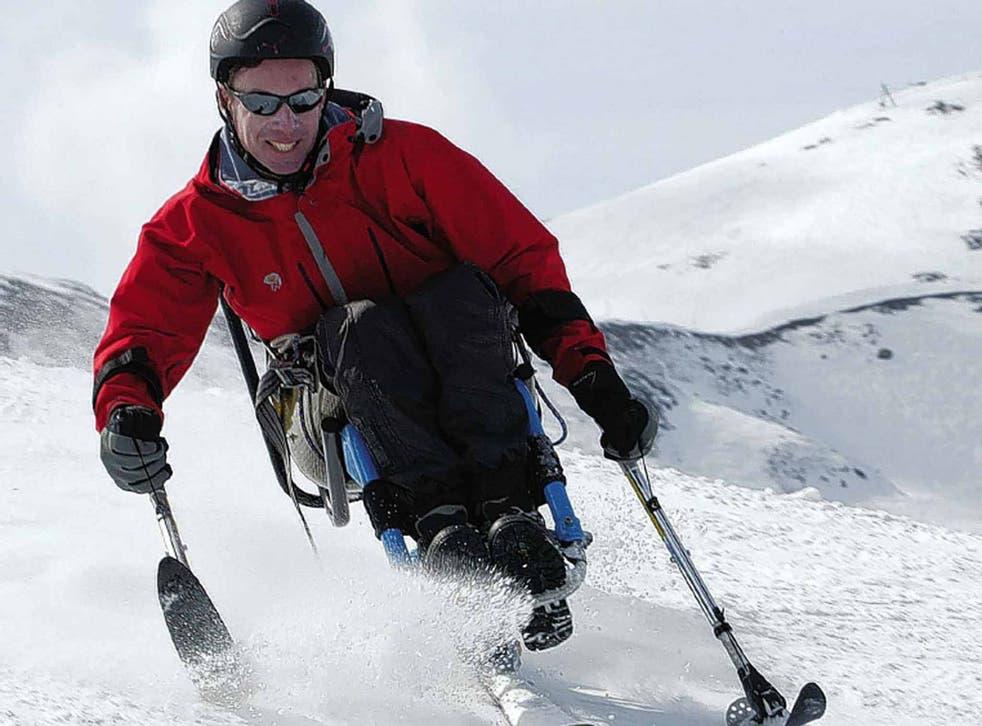
The American Spinal Injury Association's Impairment Scale (AIS) is a standardised assessment of neurological function. It ranges from A (no motor or sensory function) to E (normal motor and sensory function). Those with a C5 AIS B injury have preserved sensory function below C5 however motor function is absent
*Aitken SA et/al. Recreational mountain biking injuries. Emerg Med J 2011;28:274-279.
**Ashwell Z et/al. The epidemiology of mountain bike park injuries at the Whistler Bike Park, British Columbia (BC), Canada. Wilderness Envir Med 2012;23:140-145.
Writing about MTB injuries has been a real eye opener. I've learnt a lot. If you'd like to plug a gap in your knowledge and share your discoveries with a wider audience please get in touch. As I've learnt, there's lots of very experienced and knowledgeable people out there who are only too willing to spare some time to help! My thanks go to Mike Rodger and Tim Halsey for their assistance in preparing this post as well as Roger Barraclough, Simon Currin, Richard Dobson, Abbi Forsyth, Roger Kockelbergh, Andy Luks, Meg Owen and Mike Whiteside. Thank You!
Comments
Leave a comment.



 )
)